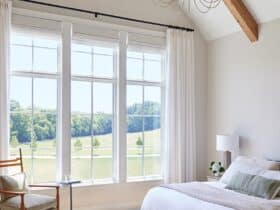Do you struggle to feel like you’ve got a good night’s sleep after working the third shift? If so, you’re not alone.
The number one complaint among third shift workers is that they never feel fully rested. Indeed, chronic fatigue is one of the biggest problems that third shift workers struggle with. It’s no surprise, as this shift requires sleeping schedules unlike any others in the workplace.
The good news is that there are solutions to this problem.
We’ve put together this guide to bedroom remodel ideas specifically for third shift workers. These solutions will help you create a restful, relaxing oasis so that you can wake up feeling energized and ready for the day ahead.
The Sleep Problem for Third Shift Workers
The most constant and serious problems that third shift workers have to wrangle with are issues related to sleep. This is due to a few factors. Frequent sleep disturbance, longer work hours, grueling conditions, and increased stress can all contribute to sleep problems.
The resulting fatigue and sleepiness are major issues in the workplace that can seriously impact performance. Experiencing symptoms of fatigue in the workplace can lead to frequently missed shifts, workplace accidents, errors in judgment, injuries, and in some cases even fatalities.
The symptoms of fatigue include:
- chronic sleepiness, tiredness, and exhaustion
- headaches
- sore and aching muscles
- muscle weakness
- dizziness
- moodiness and irritability
- loss of appetite
- blurry vision
- slowed reflexes and longer response times
- impaired hand-eye coordination
- short-term memory problems
- impaired judgment and decision-making
- reduced ability to pay attention
- poor concentration
- reduced immune system function
- low motivation
- hallucinations
It’s easy to see how experiencing several of these symptoms at once can lead to serious problems in the workplace. This is especially true for workers who have increased responsibilities for keeping the world safe and moving like healthcare workers, firefighters, and those who are responsible for keeping supply chains moving.
Furthermore, many third shift workers are employed at facilities like factories and labs. These environments present more hazards to workers and can be quite dangerous. High levels of concentration and good judgment making are required to stay safe in these workplaces.
Third shift workers who don’t get an adequate amount of high-quality sleep are also at a higher risk for heart disease, diabetes, and gastrointestinal disease.
It’s clear to see that there are serious consequences to living with compromised sleep patterns for long periods of time. Fortunately, there are several reliable ways to increase both the length and quality of your sleep.
Bedroom Remodel Ideas for Better Sleep
There are many factors that can negatively affect your sleeping pattern. Tackling them all at once can seem overwhelming or even impossible. The best strategy for improving your sleep long-term is to address potential detriments one by one.
And the best place to start is in your bedroom.
Your bedroom should be an oasis of rest, a place where you can go to recharge after a hard day’s work. There are several bedroom design strategies that you can start implementing today to create that kind of environment for yourself.
Keep in mind that you don’t have to do a full bedroom remodel all at once. Start by implementing one or two of these strategies and work from there.
Use Your Bedroom for Sleep Only
Sleep experts agree that there are only two things you should use your bedroom for, sleep and quality time with your partner. Other uses of your bedroom can negatively impact the length and quality of your sleep.
The idea is to train your brain to associate being in your bedroom with sleeping and nothing else. It’s tempting to use your bedroom for other things like watching TV or scrolling through social media. But this can make your brain associate being in your bedroom with entertainment, instead of sleep.
If this happens, your brain will go into “entertainment mode” rather than “sleep mode” when you come home from work. Your brain will remain active, even as you’re lying down and trying to catch some zzzs. This can lead to frustration, insomnia, and increased tiredness the next day.
So how do we fix this? The easiest way to make your bedroom more sleep-friendly is to remove all objects that don’t directly assist with going to sleep. This includes clutter, distractions, and any objects that don’t belong in the bedroom.
Start by decluttering your room. Clutter, even if it’s tucked away under your bed, can increase stress and anxiety, which are detrimental to sleep.
Find another place to store books, electronics, exercise equipment, piles of papers, and work supplies. It may be especially hard when you’re tired after work, but fold and put away the laundry before you go to sleep instead of leaving it in a pile on the floor or on a chair.
Declutter your nightstands as well. Many people find that clutter tends to accumulate on their nightstands and other flat surfaces, so take some time to store any items that you don’t immediately need.
Ensuring that your bedroom is neat, clean, and clutter-free will help you relax and fall asleep.
Banish the Electronics
This is a hard one, we know. So let’s talk about why the use of electronics in the bedroom is highly disruptive to sleep.
The body of a healthy adult follows a 24-hour sleep-wake cycle. In the morning when the sun rises, your body produces cortisol. This is a hormone that makes you feel alert and awake.
As the sun sets and daylight fades, your body releases melatonin. This is another hormone that produces feelings of sleepiness.
Devices like cellphones, tablets, computers, and e-readers emit short-wavelength enriched light, also known as blue light. Blue light has been proven to delay and reduce the body’s natural production of melatonin in the evening. It also reduces the amount of time your body spends in slow-wave and REM sleep, two stages of the sleep cycle that are imperative for proper cognitive functioning.
Your circadian rhythm is based almost entirely on the light that your eyes and body are exposed to throughout the day. That’s why the light from electronics can have such a massive impact on your sleep cycle.
Many people use blue light filters and blue light blocking glasses when operating electronics close to bedtime. These measures are a step in the right direction, but ultimately insufficient.
The best way to ensure that blue light isn’t disturbing your sleep is to remove all electronic devices from your bedroom. Set up your phone to charge in another room. If you have a bedroom TV, move it to another room or put it inside a cabinet.
Make sure that all the electronics are off at least 30 minutes before you go to bed. If you need pre-bedtime entertainment, consider reading a paper book or doing puzzles like crosswords or sudoku. Your body will thank you.
Invest in Blackout Blinds or Curtains
We already talked about how your circadian rhythm is dependent on your exposure to daylight. This can be a problem for third shift workers, who are often awake at night and asleep during the day.
The best way to counteract this is by making your bedroom as dark as possible. Blackout blinds or curtains are massively helpful in achieving this because they block nearly all natural light from entering your room.
There are different levels of blackout curtains that block different amounts of light. Look for ones that block the maximum amount of light.
It’s a good idea to have these curtains closed in your bedroom as soon as the sun is up. The more you can avoid exposing your body to cortisol-producing light, the better.
Check out this resource for more information on blackout blinds and curtains.
Check the Colors of Your Walls
You may be surprised to learn that the color of your walls can affect your mood and sleep patterns.
There is no one color that will help you get a better night’s sleep. But one hard rule is to use a pastel or muted version of whatever color you want on the walls of your room.
Use a single color rather than painting your bedroom with multiple shades. Having more than one color alerts your brain and can keep you awake longer.
The best colors for promoting healthy sleep tend to be on the cooler side of the color palate. This includes blues, greens, and natural browns. These colors are associated with nature and a sense of calm. However, if there are particular colors that you personally associate with relaxation and calm, use those instead.
Try to avoid painting your bedroom with warm colors like red, yellow, and orange. These colors have been proven to promote alertness, especially particularly aggressive shades. Some scientists believe that bright colors make our brains alert because many poisonous animals are marked with the same colors.
In general, paint your bedroom walls with cool colors and choose muted or pastel shades.
Make Sure You Have a Good Mattress
One of the biggest things that negatively affects people’s rest is sleeping on an old, uncomfortable, or inappropriately supportive mattress. If you wake up feeling uncomfortable, stiff, or sore, your mattress is most likely the problem.
Well-crafted and supportive mattresses can massively improve the quality of your sleep. Mattresses are not cheap. But considering the amount of time that you spend on it, ensuring that you have an excellent mattress is a wise and worthy investment.
Think about what your most common sleeping positions are and research beds made specifically for people who sleep in those positions. Take some time to try out different mattresses to figure out what blend of softness and support works best for your body.
Keep in mind that your entire body should be able to evenly spread out over the mattress to provide relief to your pressure points. Make sure that the mattress keeps your spine aligned as well. This will go a long way towards preventing back pain.
You should also look into getting a mattress that is properly sized for you and your partner. You should both be able to comfortably sleep and move around without crowding each other. Many families opt for queen-sized beds, but if you need extra room, consider upgrading to a king-size.
If either you or your partner is particularly tall, king-sized beds provide extra length. There are also extra-long queen-size models available if you prefer a smaller size.
Reducing Noise
Another thing that can negatively impact third shift workers’ sleep is external noise. This is especially true for people who have families that are awake and active while they’re trying to catch some zzzs.
Fabric absorbs sound, so think about adding rugs and upholstered furniture to your bedroom. Upholstered headboards, tapestries, and fabric wall hangings are great for noise reduction.
Rugs also absorb the sound of people walking and moving around your home. If you have the time and budget, consider having carpet installed in your bedroom if you don’t already have some.
White noise can also block out ambient sounds and help you sleep better. Box fans, aromatherapy diffusers, and white noise machines are all great for this.
Get the Good Night’s Sleep You Deserve
Third shift workers are the backbone of society. People who work in warehouses and factories keep our global supply chains running. Medical professionals, firefighters, and so many others keep us safe and healthy.
We hope that these bedroom remodel ideas will help third shift workers get the restful sleep that they deserve.
If you enjoyed this piece, check out our other articles on home remodeling today.










